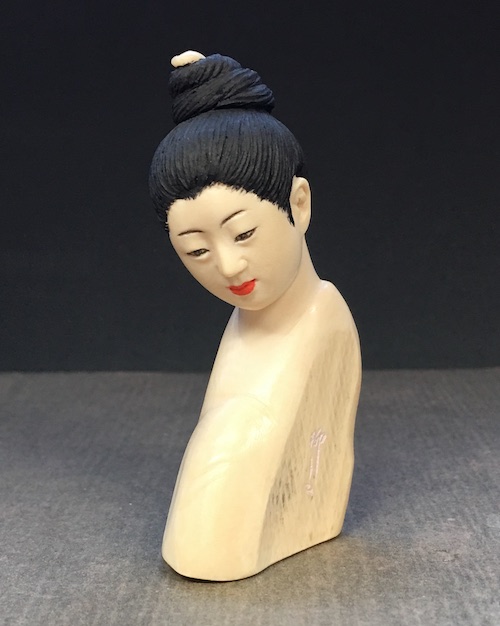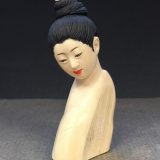This is the final footage of this series. My father applies sumi ink on the hair that had been painted in “ivory black.” Using the ink stick known as seiboku (black sumi with a very slight tint of blue), and the ink is made using a little more water than usual. The ink over the paint creates a subtly greyish or brownish hue, making the black color of the hair look milder.
From around 15:19, once the ink become dry, the hair part is “brushed” to bring out a gentle gloss (this procedure is, of course, not like brushing the real human hair, though!). The brush is made of bristles of such animals as tanuki (racoon dog).
Then, from around 17:05, my father refines the hairline with a scraper by scraping off a bit of color along the edge of the hair. He says that this is where artists can show their skill in making the hairline look real and beautiful. My father takes hints from the depictions of women’s hairlines in ukiyo-e woodblock prints.
In passing, my father had training in okimono carving, and it is sumi ink that has traditionally been used for the hair of okimono. On the other hand, sumi ink would come off if used in netsuke, since they are touched by hand. To prevent the color from coming off easily, my father came up with the idea of using wood glue to mix with pigments (and water so that the brush would run smoothly). He also conceived the idea of applying sumi ink over it to achieve a favorable color. In addition, his ideal finish (of the colored areas) is matt rather than gloss, just as the works of Inada Ichiro. In fact, my father was inspired by Ichiro-san’s works to paint colors on his own pieces.
At around 27:06 he “brushes” the head again. My father says that this gives a sheen to the hair, and the V-shaped grooves of the hair (made using the tatagiri-bori technique explained in part 2 of this series) augment the sheen.
Now that the coloring of the hair is over, my father moves on to paint a white color on the decoration of a hairpin on top of the bun (from around 31:36). The paint is pure titanium mixed with wood glue. He then applies the same paint on the signature that was carved in advance.
The piece is now complete. Until the very end, however, he was troubled by pores of the black paint, and this shows how demanding the mammoth tusk can be as carving material.
Incidentally, my father puts the piece on a somewhat distant area of the carving post every time he takes a break. This is just like a painter working on a large painting would walk back a few steps to see the painting as a whole. Viewing from a distance can help make sure, for instance, whether what has just been done was successful or whether the piece is well proportioned as a whole, i.e., the things that cannot be easily discerned from close proximity.
Thank you for watching this series until the end!
This post contains affiliate links. Koryuen participates in the Amazon Affiliates Programs. If you purchased a product through an affiliate link, Koryuen will receive a small commission, while your cost will be the same. Thank you for your understanding and cooperation!

